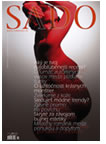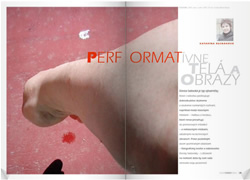 |
|||

Performative Bodies and Images
Katarína Rusnáková
Dorota Sadovská is the kind of visual artist who joyfully accepts the adventure of researching and opening various boundaries, for instance between traditional media (painting and drawing, which often pass over into space installation) and non-traditional media based on technical images. I would like to focus on two areas, namely Dorota Sadovská’s photographs and video installations, with emphasis on certain of her works.
The common denominator of Sadovská’s photographs and digital moving pictures is the set of topical issues relating to the body and corporeality, where the factor of time and process is an integral element. But among their other distinguishing marks is the fact that they are based on apparatus, and this equally is connected with time. While on the one hand a photograph means time halted, with the possibility of simulating the flow of time by the seriality of shots, on the other hand the moving video image represents multiple time. One can say that it is time with an objective dimension, relating to technology as the condition for presentation of an artwork, but also with a subjective dimension, relating to the author’s approach to time – here the artist can manipulate the fast or slow speed of the digital moving pictures. In this category one must also take into consideration the viewer’s individual time, needed to perceive the work in its medium.
It is interesting if we look at those works of Sadovská’s, variously structured with respect to time, in which she multifariously depicts metamorphoses of her own body or other female or male bodies in relation to the pulse of everyday life. Here photography and video become visual media for the artist, to be used for the (self-) reflection of corporeality in the broader context of socio-political and culturo-social reality; at the same time, she subverts stereotypes about women who are thought of in the first instance, either as erotic objects, making an impression by their sexiness, or meticulous housewives presented through idealized images in the advertisements, mainstream movies or soap operas. Sadovská articulates the issue of body and identity with its coded gender aspects from a personal or even autobiographical viewpoint, emphasising the knowing subject as the source of her own experience, which raises the issues of phenomenology. Because by means of our experience we not only discover the world but we also become aware of the experience of other people.
If we look at Sadovská’s Corporalities (2003), it is evident that this photograph series represents a certain level of subversion in approaching the depiction of a female body. The artist studies or, through violent microprobes, examines a female body, in particular breasts as the symbol of femininity, erotica and sexuality, which become an object of a whole range of by no means gentle touches visited on them by hands. This series of etudes-in-performance, focused on the erogenous zones, denies sentimental views of the female body and infringes the stereotypes of gender and sexual behaviour. Sadovská operates with the metaphoric nature of the female body, concentrating on mutual connections between the haptic and the visual, with female breasts serving her as “sculptor’s material” for moulding, deforming, kneading and manipulating. This evokes an impression of ambiguous private body art rituals – from declension of breast variability in the form of a kind of body dictionary, through non-erotic positions referring to the medical issue of self-examination of the breasts, to the author‘s individual coping with abuse of female images in the mass media in which women are mostly represented as one-dimensional, beautiful, young and slim human beings, with no entry into their mental world and sensibility.
This series of Sadovská‘s photographs communicates on a related “semantic wave“ with the colour photographs of the Cuban-American Ana Mendieta (1948–1986) which are products of her body art performances dating from the 1970s (Untitled / Glass on the Body, 1972). These involved cruel manipulation with fragments of the artist’s own body which she deformed using sheets of glass. She concentrated on squeezing out of shape the erogenous zones associated with sexuality and maternity which symbolize the ambivalent feelings of pleasure and rapture, pain and torment.
Sadovská‘s videos belong to a seemingly different but in a certain sense similar thematic area, focused on blown-up details of a body where Sadovská demonstrates her inventive perception and sense of experiment. One such is Slough (2003) designed by the author as a flat, digital image displayed on an LCD TV screen hung on the wall. The form of the video, resembling video essay, is a model example of reflection on the transformations of the image from painting through photography and moving pictures – film, television and video – up to contemporary digital media based on advanced technologies, where one can see a shift with the mutual creative blending of functions between traditional and digital image media. This approach at the same time points to the openness, creative flexibility and resourcefulness of the author, who does not restrict herself to one medium or a limited number of themes, in order to avoid a premature stabilization of artistic opinion and freezing of artistic practices. In this metaphoric video Sadovská makes sophisticated use of the creative principles of painting, ingeniously moulded into a digital image, while simultaneously working with aspects of photography and video in relation to their performance element. Its essence involves blown-up details of fragments of the hands, legs and feet of unidentified male and female bodies which are mutually intertwined and which form body configurations in a more than one-hour-long interval of slowly flowing time. It represents a sort of process in a digital image on the wall, accompanied by the music of Martin Burlas. One thinks of a shifting visual puzzle, challenging the spectator to guess which parts belong to male and which to female bodies, and this affects the time-length of reception. Thus the video artfully seizes the attention of those noticing and suggestively holds it for a longer time.
Intermedial overlapping of painting and media art, as demonstrated in this video, may be thought of as a progressive shift; also worth mentioning is the large LCD monitor selected, which by its appearance and flatness competes rather with the canvas than the TV screen. The creative principles of Sadovská’s video remind one of artistic practices employed by the British artist Sam-Taylor Wood in her short DVD-film Still life (2001, 3‘44‘‘) adjusted in a similar way to the form of a flat screen on the wall, evoking this traditional fine art genre. Wood depicted the theme of the slow flow of time through a still life with fresh fruit undergoing gradual decay in inconspicuously ongoing phases of ageing, rotting and disappearance, whereby she literally visualized it as natura morte.
The video titled I must be better (2001), inspired by the seemingly banal use of such ordinary material as human hair, is also experimental. If we think of hair as the product of a human body and a symbol of female beauty, then the video-drawing with the author‘s hair on the surface of the table does not induce aesthetic experience only, but also a wide range of ambiguous thoughts. Sadovská appropriated "poor" material ready-to-hand to make hair drawings and create various abstract compositions and visual structures evoking minimalist drawings or miscellaneous variations – for instance, chaos theory metaphors, organic fibre clusters and the like. This process of endless creation of new visual shapes, forms, lines and compositional variants, immediately followed by deletion performed by the author’s hand, are accompanied by particular sounds of the household along with echo of the street traffic. The video ends wittily when a tangle of the author’s hair is hidden between the slices of ham, which results in a somewhat untraditional fusion of the human and the animal.
An unusual biomorphic body was depicted in the video Cocoons (2003), whose central object was a blown-up detail of the fragment of a hand metamorphosing in computer animation into a weird hybrid of a human limb and a strange beast. This semantically ambiguous object which changed its surface like an amoeba in response to the metamorphosis of light and darkness, with Martin Burlas's electronic music sounding, gave the audience scope for creating several ambiguous chains of association. Sadovská successfully presented this video at the international INOUT video festival in Prague in 2003, along with another video entitled Happy war, also created in 2003, which has evident connotations of social criticism. Questioning the sense of basic military service for men, which was compulsory until recently, it goes on to touch upon the traumatizing facts, implications and tragic consequences of the war in Iraq. The author visualizes these issues without moralizing or sentiment; quite the contrary, she has found a witty form of some sort of video-aphorism in the manner of looking at an ambivalent iconographic motif. The essential setting of this open-ended video is a segment of the staircase in an unspecified building shot from above, where young men wearing only gym shorts run up and down, beating one another constantly, and all this goes round in a loop. Without doubt this performative video evokes not only the picture of army drill but also the current issues of violence and bullying. The expressive rhetoric of the body in this video relates to the male subject and the associated problem of the power, superiority and inferiority, positions which are mutable by their very nature.
Sadovska’s performative bodies and pictures, selected from present moments of everyday reality, surprise by the interesting visuality of their blown-up details and close-ups of various bodily realities, which are immersed in the ever-flowing and mutating physical and mental environment, with its many-sided connections to the socio-cultural and political context.